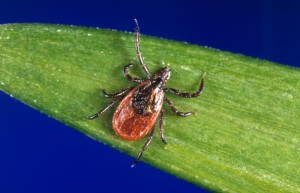Helpful tips to check for ticks!

Deer population is prevalent in Montclair due to the woodlands and mass amounts of plants and gardens. Although deer are seemingly harmless, it is crucial to avoid contact with them because they are home to ticks. Residing ticks may carry B. Burgdorferi, which is a bacterium that causes Lyme disease. Specifically, during April through September, the tick population is most widespread. The NJ Department of Health reports that 3,200 new cases of Lyme’s disease are diagnosed every year. The CDC reports that 95 percent of confirmed Lyme disease cases in the U.S. were reported from 14 states, including New Jersey.
The Mills Reservation County Park, located adjacent to the Montclair State University campus, is a popular trail and hiking area for both the county residents and the university community. Dozens of ecology classes and field experiments are conducted at the site every semester. The park consists of a deciduous forest and wetlands with an abundance of animals and plants. However, tall grass and dense vegetation, especially during the warmer season, provide a perfect environment for tick infestation; animal populations also contribute to the spread of tick species.
To protect from tick bites:
- Minimize the exposure of your skin by wearing long-sleeved shirts, pants, shoes and socks that cover your feet and ankles entirely.
- Avoid the area with a high chance of tick infestation, such as thick bushes and tall grass.
- The CDC recommends using repellents that contain 20-30 percent DEET on clothing and exposed skin for protection that lasts several hours.
- Always check your body for ticks after being outdoors.
Due to their microscopic sizes, it is easy to overlook ticks that are attached to your clothing, body or your pets. Ticks look like insects, and many people assume ticks are simply just bugs; but they belong to a class called arthropods, which include spiders and mites. All ticks are external parasites, but their physical shapes, food preferences and the habitat they reside at differentiate them. During the larvae stage, ticks have three pairs of legs (just like insects). During their adult stage, ticks grow an extra pair of legs (resembling spiders).
Ticks can be found living in an animal’s fur, forests and bushes, even inside of clothing. According to CDC, the species commonly found in New Jersey are Blacklegged Tick, Lone Star Tick, American Dog Tick and Brown Dog Tick. These tick species do not directly cause diseases but the pathogens they carry, such as bacteria and viruses, cause mild to severe symptoms in humans, including Lyme disease and Rocky Mountain spotted fever.
If bitten by a tick seek medical attention immediately. Remove the tick as soon as possible because the disease will transmit if the tick stays attached for more than 36 hours. While the weather is warming up, be mindful of ticks to prevent tick-borne illnesses.

You must be logged in to post a comment Login